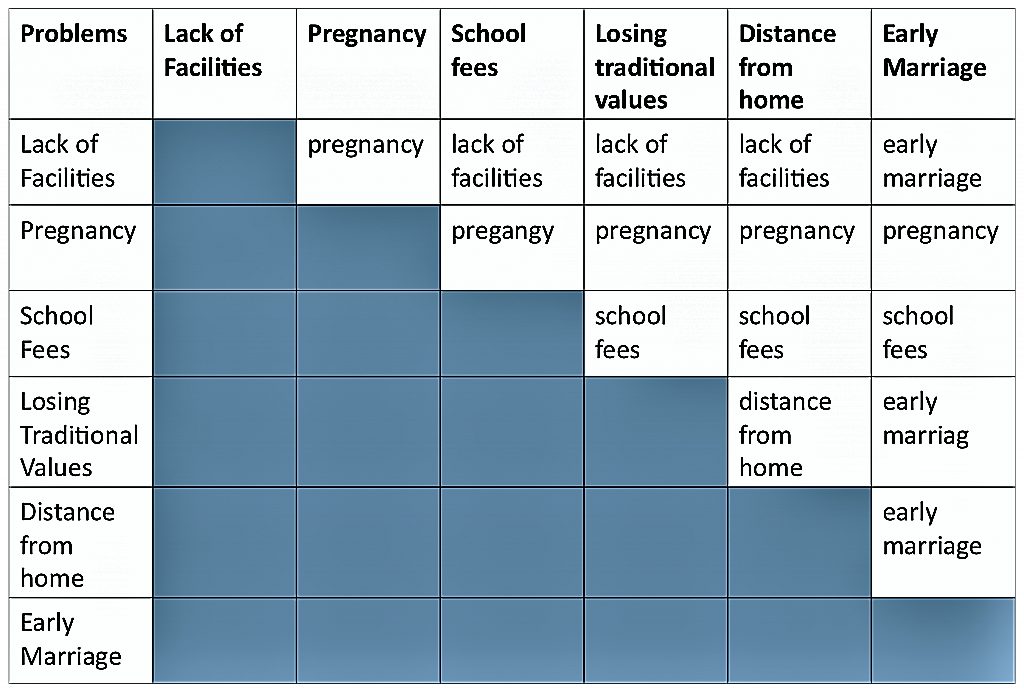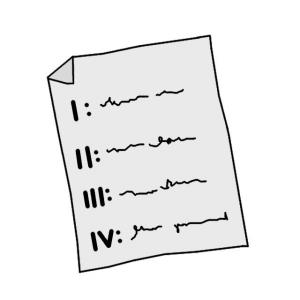Resumen ejecutivo
Problem/Preference Ranking is a participatory technique that allows analysing and identifying problems or preferences stakeholder share in order to implement adequate improvements and solutions in their community and area. First, the stakeholders have to decide which the most important problems they face in their community are. Afterwards, the participants have to rank these problems/preferences in regards to their importance. The result of this method provides the starting base for discussions on possible solutions to the priority problems.
Introduction
Preference/Problem Ranking is a participatory technique based on analysing and identifying problems or preferences stakeholders share. In order to implement improvements and solutions for water and sanitation problems communities face, you first have to analyse and identify the problems and priorities stakeholders share.
Several different techniques can be used to obtain the local people’s perceptions of the most important problems they face regarding a particular issue. One simple participatory method is to ask participants to list the main problems their community are confronted with. Afterwards, ask them to rank these problems in order of importance (see also situation and problem analysis, one of the Decision Making section).
A more systematic technique is called “pairwise ranking” and uses cards to represent the different problems. The facilitator shows the “problem cards”, two at a time, each time asking, “Which is the bigger problem?” As the participants make the comparisons, the results are recorded in a matrix.
The final result is obtained by counting the number of times that each problem was judged to be the larger problem over the others and arranging them in appropriate order.
There are usually more problems, needs or opportunities than resources can solve, provide for or exploit. Under such circumstances there is need for instruments that assist the community as a heterogeneous group to get as close to their priorities as possible. These priorities are the ones that receive preference. Ranking provides information on both the choices people make and reasons for the choices. It can be used to compare preferences and priorities between groups in a community.
Why to Use Problem/Preference Ranking?
Preference/Problem ranking method helps to quickly get a good idea of what people think are the priority problem or preferences. The criteria attached to make up a choice are used to consider in the community action plan. Individuals or groups vote on the items from most important to least important item. The choices could be between water points, problems, solutions and many other issues, which require preferences. Pairwise ranking is used to compare between two items and decide which is the bigger problem. Ranking can be combined with exploring the reasons why people consider a problem to be larger than another one, or prefer one possibility to another.
Preference/Problem ranking is probably the easiest method to use and to learn more about commonly shared problems and priorities. It is usually used trying to:
- Determine the main preferences and priorities of individuals or groups for a set of items (such as, government services, water conservation measures, etc.)
- Compare the priorities of different groups against one another (men and women, young and old, rich and poor etc.)
Subscribe here to the new Sanitation and Water Entrepreneurship Pact (SWEP) newsletter. SWEP is a network of organizations joining hands to help entrepreneurs design and develop lasting water and sanitation businesses.
How to Conduct a Problem/Preference Ranking?

Choose the theme of the ranking, depending on the area of investigation.
- Ask the participants to select about six of the most important problems or alternatives related to the theme.
- Note down each of the six problems/preferences on a separate card — use pictures or symbols instead of text, where possible.
- Place two of the cards in front of the interviewee and ask him or her to choose the bigger problem and to give reasons for the choice. Mark down the response in the appropriate box in the priority-ranking matrix.
- A preference matrix has two identical lists of problems or alternatives, one across the top (x-axis) and the other down the left side (y-axis). Each open box or cell in the matrix represents a paired comparison of two items or alternatives.
- Present a different pair and repeat the comparison.
- Repeat until all possible combinations have been considered.
- List the problems in the order in which the interviewee has ranked them by sorting the cards in order of priority.
- Check with the interviewee whether any important problems have been omitted from the list. If there are any, place them in the appropriate position in the ranking.
- Repeat the pairwise-ranking exercise with other individuals and tabulate their responses.
- If appropriate, use the ranking to begin a discussion about potential solutions to the priority problems.

The method of problem/preference ranking was originally applied mainly in agriculture and forestry. Subsequently, the technique has been employed in almost all fields also in the water and sanitation sector.
Problem/preference ranking is usually used trying to:
• Determine the main preferences or problems of individuals or groups
• Compare the priorities of different groups against one another
The criteria attached to make up a choice are used to consider in the community action plan. Community action plans are developed on the basis of people’s preferences. The problems, solutions technical inputs are arranged on the interests of the users.
Participatory Learning and Action: A Trainer's Guide
Participation and Social Assessment: Tools and Techniques
This resource kit aims to share information and experiences on participatory methods in the context of development cooperation. The primary focus concentrates on providing practical guidance and case examples.
RIETBERGEN-McCRACKEN, J. NARAYAN, D. WORLD BANK (1998): Participation and Social Assessment: Tools and Techniques. Washington: World Bank URL [Visita: 10.05.2010]Training Manual on Participatory Rural Appraisal
This handbook introduces various participatory tools used within the participatory rural appraisal framework.
ADEBO, S. (2000): Training Manual on Participatory Rural Appraisal. Addis Ababa: My Fire Community URL [Visita: 07.07.2019]Participatory Rural Appraisal. Rural Travel and Transport Program 2001
This document explains various tools of the participatory rural appraisal (PRA) framework. PRA is a collection of approaches and methods to enable local people to share, enhance and analyse their knowledge of life and conditions to plan and to act.
DAVIS, A. S. C. (2001): Participatory Rural Appraisal. Rural Travel and Transport Program 2001. London: TRL Limited. [Accessed: 15.09.2010] PDFParticipation and Social Assessment: Tools and Techniques
This resource kit aims to share information and experiences on participatory methods in the context of development cooperation. The primary focus concentrates on providing practical guidance and case examples.
RIETBERGEN-McCRACKEN, J. NARAYAN, D. WORLD BANK (1998): Participation and Social Assessment: Tools and Techniques. Washington: World Bank URL [Visita: 10.05.2010]
